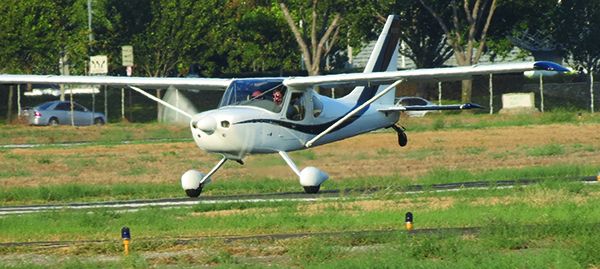In the March 2021 issue, I discussed the need to restructure the way we teach flying, to focus ab initio training on developing habits that don’t have to be unlearned as one progresses through flight training and into advanced ratings and operations. The classic example is developing in students the habit of using airspeed as a measure of how close the airplane is to stalling. As I discussed in that article, the problem with developing this habit is that angle of attack (AOA) is what determines how close we are to stalling, and that airspeed is only one (imperfect) way to measure it.
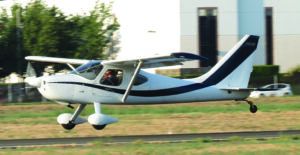
Habits are learned things that we do when certain cues or trigger events are recognized by our senses and sent to the brain. Almost everything we do routinely eventually becomes habit. The problem is our brain can’t quickly tell us the difference between a good habit and a bad one. Flying an airplane is no different. If you are landing on Runway 36 and winds are from 090 at 10 knots, your brain tells you that you have a crosswind from the right. The way you compensate for the crosswind, smoothly touch down and maintain directional control as you roll out is learned behavior, a habit formed after training and practice.
HABITS IN THREE DIMENSIONS
We humans have a lot of habits useful in a two-dimensional world of normal life, but which are not so useful when flying an airplane. Some of them, in fact, are outright dangerous. When driving, for example, we add power to go faster. To slow down, we apply brakes. Both functions are enabled by tire friction on the road created by gravity. When we begin learning to fly, we bring all those cues and habits with us. So, when that to-be pilot does his first takeoff, the act of pushing the throttle in just like when we want to go faster with a car becomes a relationship-triggering cue.
Initially, it is a valid cue because at the time throttle is added for takeoff, the airplane is still in the two-dimensional world. But the moment the airplane becomes airborne, it (and the pilot/passengers) is/are no longer dominated by the rules of a two-dimensional world. It’s now in a three-dimensional world where it can and does create its own form of gravity. And, as might be expected, many, if not most, of the “rules” governing a two-dimensional world are transformed. Accordingly, many of the “habit rules” also change.
The new three-dimensional world now controls the force of gravity, becoming at best, a source shared with the airplane’s self-created gravity derived from lift in the three-dimensional element of an airmass. In this three-dimensional environment, the airplane climbs (goes away from the earth’s surface) as a function of power in excess of the amount needed to balance lift with gravity. Adding power does not necessarily make the plane go faster as it does when adding it to a car. In the three-dimensional environment, the airplane goes faster or slower as a function of the wing’s angle of attack.
In wings-level cruise flight, pitching the airplane’s nose up or down changes the angle of attack—using the air surrounding the airfoil to either add speed or to achieve a slower airspeed. In the three-dimensional world the airplane inhabits, speed is not necessarily a function of adding or removing power.
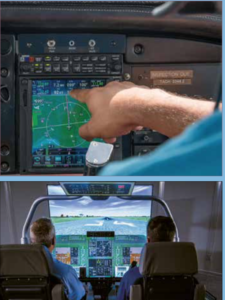
As this article’s main text discusses, there are fundamental differences between the dynamics of moving in the two-dimensional world and the aerodynamics of the three-dimensional world. Over time, with repetitive training, two-dimensional flying habits come to have the “look and feel” of three-dimensional habits even though the fundamental core of the habit is different.
It’s critical to know that habits are things we do automatically, triggered by visual or situational cues. They happen before we even think about them and, often, without thinking about them at all. In flight, a two-dimensional habit can often trigger an incorrect result, which then is corrected as soon as the cognitive mind recognizes the error. But cognitive recognition can take time, a second or longer. If there is time to recognize the error, safe flight continues.
However, a two- or three-second delay for cognitive thinking to recognize that an incorrect habit response has been triggered can be risky when a “surprise” or “unexpected” events triggers the wrong habit cue. Those incorrect habit responses have induced a close-to-the-ground stall from which there is insufficient time to recognize and correct the mistake.
The author’s study of loss-of-control inflight (LOC-I) incidents seems to indicate that incorrect response to aerodynamic cues induced recall of a two-dimensional habit in lieu of recall of a three-dimensional habit. And as is clear from the statistics, LOC-I remains the number one cause of fatal accidents
TRANSFERRED HABITS
Many pilots learn to fly by modifying the cues they first learned in driving an automobile. In hindsight, I most assuredly did, and in the intervening years little has changed with respect to understanding how driving habits are transformed to flying habits. Partially in response to learning to operate ground-based personal transportation—an automobile— airspeed is often the primary metric to determine aircraft control among ab initio students. In one sense, this is okay in that it allows pilots to hone driving habits to meet aircraft flight needs. But it fails to teach pilots how to deal with the true aerodynamic elements of flight in critical or surprising situations. Support for this habit is found in FAA-approved pilot handbooks and operating manuals, where some critical aspects of flying all reference airspeeds, not pitch-and-power criteria.
While pilots often intellectually understand pitch-and-power flight paradigms and can deal with the concepts cognitively when taking their written and flight exams, core flying habits often remain cued by the driving habits learned in the two-dimensional world. Little or no effort in flight training addresses habit-building aspects that should be used for safer flight.
As a pilot, how can you know to what extent your flying techniques are controlled “modified driving” habits taken from our two-dimensional world or “pitch and power” habits needed for safe aerodynamic flight in the three-dimensional world? Let’s explore how habits can be transferred from the two-dimensional world to the one in which we fly.
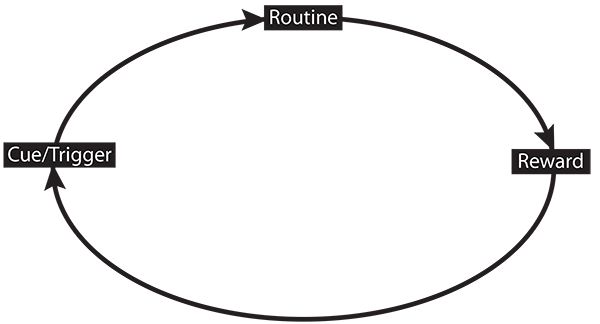
Identify the Cue
Stress often is a trigger for a habitual response. As you become more familiar with the operation, it becomes less stressful and easier to identify.
Avoid the Cue OR Find a New Routine
Make it easier on yourself to break bad habits by avoiding the things that cause them. The earlier the bad habit is identified, the easier it is to avoid and/or replace it.
Expect New Result
When you change your behavior/habit, expect a different result. Embrace the famous quote attributed to Albert Einstein—that insanity is doing the same thing over and over again and expecting different results—by changing your responses to the cue.
Cognitively repeat until New Routine becomes Habit
Habits are encoded into the our brains and the only way to change them is to to identify the habit’s trigger, take a different action and observe the new result.
Obtain Clear Result that is identifiably better
It’s hard to change a habit when the result of the new behavior isn’t clear. Making better landings can be its own reward, for example.
CHASING AIRSPEED
Chasing airspeed is a common carryover habit where the pilot shoves the nose of the airplane to the pitch attitude that is anticipated and then uses changing combinations of pitch and power to achieve the airspeed desired or expected. This scenario can be seen following a climb to cruise altitude, a request by ATC to maintain a given airspeed and very often during landing approaches. This technique is reinforced by the FAA’s focus on airspeeds in manuals, rules, regulations, training material and doctrine.
Airspeeds are a function of pitch and power settings. Pilots should know and fly to pitch and power settings, and use airspeed as a verification once the airplane is stabilized in the correct pitch and power setting for the desired phase of flight.
DRIVING THE AIRPLANE
That our early aviation habits often are formed in automobiles on the ground is generally most obvious during landings. Pilots identify the intended landing target and then attempt to “drive” the airplane to it by using the yoke as a steering wheel to aim the airplane at the target. Configuration changes result in pitch and power excursions as the pilot attempts to keep the airplane pointed at the target using pitch and roll alone. Even the most sophisticated of these approaches are unstable and landings are inconsistent.
Pilots flying pitch-and-power landings reduce power while maintaining a stable pitch attitude with the aiming point lying just above the nose. Pitch is used to control airspeed only and power is to control the sink rate. Flaps are used to maintain a slower airspeed at roughly the same attitude during the initial approach phases, and added when the target is assured to slow the airplane to minimum flyable airspeed at touchdown.
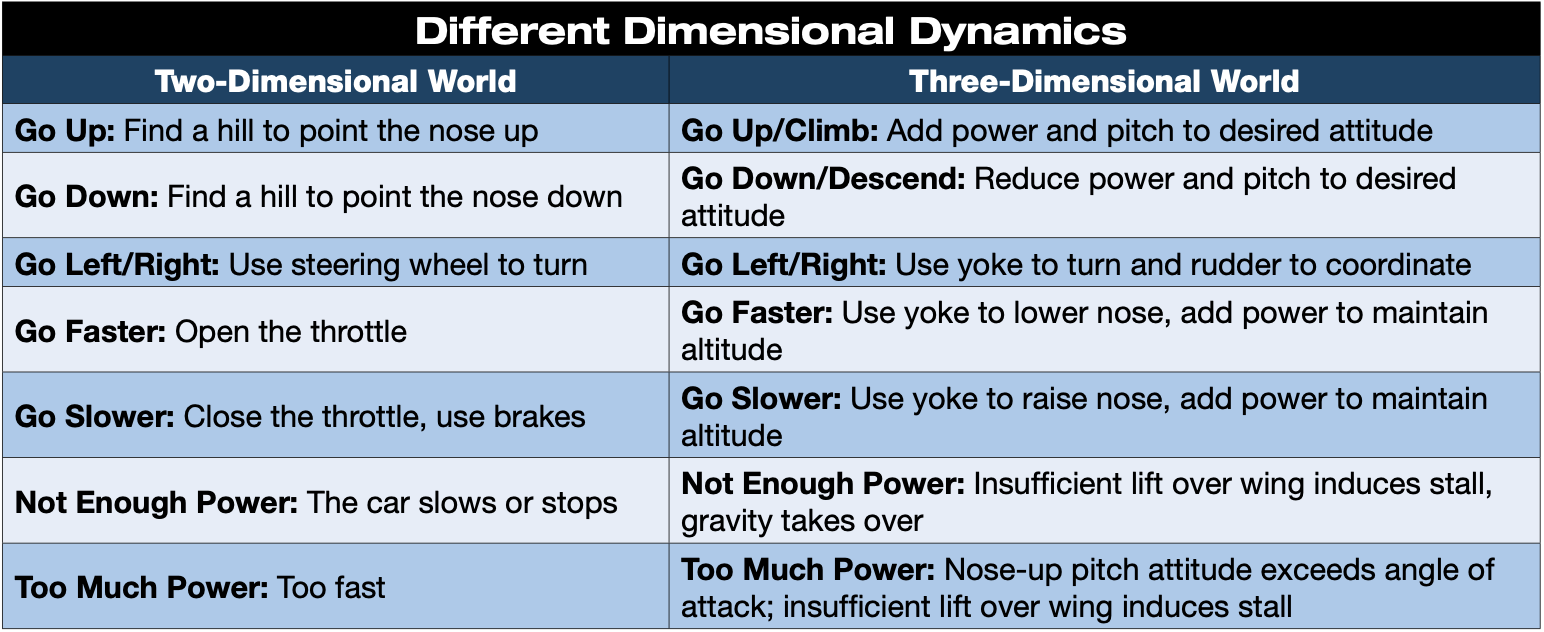
CROSSWIND LANDINGS
Crosswind landings are often a real problem for a pilot with two-dimensional flying habits. The pilot points the airplane at the target as if driving it to the runway, as described previously, but the crosswind moves the airplane away from the target. So, the more sophisticated two-dimensional pilot reacts to the point that a crab approach seems to be working. This varies, depending on pilot experience. Perhaps like you, I’ve experienced approaches flown by other pilots that were a constant series of pitch and bank attitude changes.
This oscillating directional control continues over the runway and, with luck, the pilot forces the plane onto the runway during the oscillations. The landing is invariably fast, hard and cross-loads the landing gear. Experienced two-dimensional pilots will sometimes try to add some cross-controlled rudder/aileron control, but it rarely is sufficient to control the drift.
Correctly flown crosswind landings should be in a stable approach configuration as described above, using pitch and power to control airspeed and descent rate. A crab can be used to offset the crosswind, with the plane kept at an angle into the wind throughout the approach so that its path to the runway is aligned with the extended runway centerline. A cross-controlled, wing-down-into-the-wind slip can be used to keep the plane’s nose aligned with the target and extended centerline. Some experienced pilots and those confronting stiff crosswinds find that a combination of these two crosswind techniques—the crab and the slip—often work well.
If a crab is used in the approach, it should transform into a wing-down-into-the-wind slip during the roundout and flare so that the upwind wheel touches down first, at minimal flying speed. If a slip has been used throughout the approach, it should be slightly increased in the roundout and flare to ensure minimum flyable airspeed at touchdown.
STALLS
Stalls are a classic problem for pilots who have not overcome their two-dimensional habits. As the wings lose lift, the airplane becomes almost totally subject to gravity. The habit cue seen by the pilot is one of falling. The initial reaction is to pull nose-up on the pitch control. But, in many cases, that initial habit cue has been supplemented by a “fear habit” drilled into the pilot by his/her flight instructor—to shove the nose aggressively down to regain lift. Both habits are two-dimensional. In general aviation aircraft, the correct pitch-and-power response should be to ease the nose down to the point that airflow of the wing generates lift steering with one’s feet and use gravity to establish a pitch attitude that generates lift.
PUTTING IT ALL TOGETHER
What we learn and why before we begin flight training impacts how well we progress and can convert older, learned habits that may not help us in the cockpit. Realizing the root causes of those bad habits is the first step toward changing them and becoming a better, more skilled pilot.
Richard Eastman is retired software executive and a 13,000-plus-hour CFII/MEI who also serves as a FAASTeam Representative. He built a Glasair Sportsman and conducts transition training in the type.

